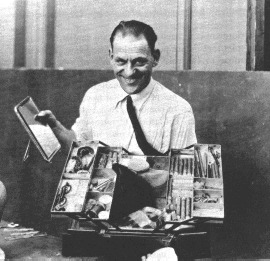Around this time, Lon had joined Universal Studios, and though he appeared in dozens of comedies and actions shorts, his true fame was still years ahead. Stardom was not of prime importance to Chaney; he was working steadily and making better wages than any other time in his life. He thought that only a handful of film talent like Charlie Chaplin, Douglas Fairbanks, and Mary Pickford were recognized as "reigning celebrities". As long as Hollywood needed good character players, he felt that he would always be in demand, and this seemed to satisfy him. His wife, Hazel thought differently. She felt that he was just as talented as any of the featured players who were commanding greater paychecks. Upon her urging, Chaney requested a special conference with Universal's studio manager William Sistrom. He asked for a better salary, a $50.00 increase over his $75.00-a-week earnings. Sistrom's response was less than negative, as he pointed out in scathing detail that character actors of Chaney’s "ilk" weren’t worth more than $100.00 a week. Sistrom's counter offer was of the "take-it-or-leave-it" kind. For the first time, Chaney realized how much the studio had been exploiting and short-changing him. Rankled and unable to forget Sistrom’s rather cold response, years later, Chaney would make it a moral point of getting $50.00 a week more added to his contracts, regardless of how much he was offered. It was late in the year 1918 that Chaney - no longer and unknown - would leave Universal for bigger and better opportunities. At that time, the film industry undergoing a few "growing pains", as the major companies were battling over dominance while the smaller companies were fighting to stay alive. This competitive warfare created a tight job market for "freelancers". Chaney was nearly forced to return to Universal, when William S. Hart, one of the screen’s biggest box-office stars asked Chaney to appear opposite him in Hart's next major film. The film was called Riddle Gawne, and this paved the way for more roles in many other productions. Within a short period, Lon Chaney became sought after as Hollywood’s most versatile and unusual character players. He would play a wide range of characterizations that included gangsters, pirates, beggars, cowboys, cripples, comedic roles, and even straight-type characters. Around 1919, he was tapped for a role in The Miracle Man. Chaney played the character of Frog, a twisted cripple who is restored to health by faith-healing. Somewhat of a contortionist, Chaney was able to bend and twist his legs to assume the desired effect of a cripple's condition for the camera. The film was a box-office success, propelling Chaney into greater recognition. In 1920, he commanded $500.00 a week for his performance in The Penalty. Next came While Paris Sleeps (originally tiled, The Glory Of Love), which marked Chaney’s "official" excursion into the Horror genre. The finished film was considered so grim, that its release was held up for nearly three years after it was completed. He followed up these films with Shadows, Oliver Twist, and Blind Bargain in 1922. Also in that same year, Chaney would return to Universal Studios in full glory as a number one box-office commodity. His first contract would have him star in The Hunchback Of Notre Dame. He was now being paid more than $10,000.00 a month by the same company who did not think he was worth more than $100.00 a week five years before. The film required nearly a year of Pre-Production. This also involved the construction of massive sets; duplications of early Parisian buildings and the great façade of the Notre Dame cathedral (which was so well-constructed, it still stands to this day). Chaney would come to the set each morning four and a half hours earlier before the usual call time, to make the painful transformation into Quasimodo. Chaney would harness a 72-lb. mound of heavy rubber to his back (this was before the age of lightweight plastics and latex foam rubber). He would also don a breastplate and shoulder pads similar to that worn by a football player. A leather harness resembling a corset would hold both the back "hump" and breastplate together, and over the top, he would wear a flesh-colored rubber suit. Utilizing his make-up mastery, he would apply modeling putty around the features of his face to achieve the disfigured countenance of Quasimodo. He used animal hair to fashion himself a wig. Tufts of more animal hair were glued to the rubber suit he wore. A protruding eye and a set of crooked false teeth were added to complete Chaney's transformation into the hideously deformed hunchback. This transformation was not without a price however, as Chaney was hospitalized for three months after the film's completion. His suffering had paid off in the end; the film was a box-office hit. Lon Chaney’s spectacular performance catapulted him beyond his already popular status as one of the era's leading talents. The following few years yielded more success for Chaney. During this time, he made such masterpieces as The Next Corner (1924), He Who Gets Slapped (1924), The Monster (1925), and the exquisite classic entitled, The Unholy Three (1925). Directed by Tod Browning, The Unholy Three was so unique, that it was remade with sound five years later, again starring Chaney. This film was indeed a masterpiece and one of Lon Chaney’s most brilliant performances - but his crowning achievement has to be The Phantom Of The Opera, which was also made in that same year. Chaney's awe-inspiring performance and make-up for The Phantom Of The Opera made that film the enduring classic it still is today. Chaney himself controlled and directed many scenes, and undertook great steps to create the Phantom make-up. To achieve perhaps the most memorable face of horror in cinematic history, he used an intricate combination of make-up and devices - many of which were among the secrets he carried with him to the grave. Much like a magician, Lon Chaney never liked revealing his many secrets and techniques. It is known that he often used a combination of lighting and face paints to achieve certain effects. For his Phantom make-up, it is known that he wore a wig of stringy hair that was attached to a false forehead, built up by what could have been modeling putty to help make his head appear more skull-shaped. He taped his ears flat against his head, and somehow taped his nose so that it would turn upward. He built his cheekbones up with putty and greasepaint, and painted large black circles around his eyes. He also painted fine lines and wrinkles around his mouth. To complete his ghastly death's-head-like appearance, he also wore a set of false teeth. 1926 saw Chaney teaming up with director Tod Browning again on three more films: The Blackbird (which cast Chaney in a dual role), Outside The Law (with Chaney as a gangster), and the Road To Mandalay. In 1927, he went on to make Mr. Wu, which features Chaney in several different and incredible make-up transformations, as the film follows the life of a Chinese man - from adolescence to senescence. In this same year, he worked with Tod Browning again on The Unknown, an interesting film about a circus performer (Chaney) pretending to be an armless knife-thrower whose agile footwork compensates for his "handicap". The knife-thrower makes the mistake of falling in love and becoming obsessed with that love - ultimately costing him both his arms in the film's shock ending. In that same year, Chaney would collaborate yet again with Tod Browning on what would be another landmark film for both actor and director. The film was MGM’s London After Midnight, which would feature Chaney in another horrific role comparable to his performances as Quasimodo and Erik. Aside from playing the vampiric character of Roger Balfour, Chaney played two other roles in this film as well. More interesting, is that London After Midnight was the first American-made film dealing with vampirism. Unfortunately, prints of this classic gem are scarce at best. Tod Browning filmed a remake of his classic London After Midnight for MGM once again in 1935. Entitled Mark Of The Vampire, this version starred Bela Lugosi, Lionel Barrymore, Elizabeth Allan, and Lionel Atwill. |
||

